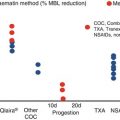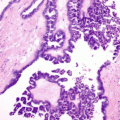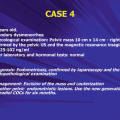1. Increasing age
2. Increasing body weight
3. Pregnancy/post partum
4. Hormonal contraceptive pill as estrogen/progestogen combination
(a) Type of estrogen (EE, E2, E2V)
(b) Estrogen dose
(c) Type of progestogen in combination with an estrogen
(d) Dose of progestogen
(e) Length of use
(f) Type of application (oral, vaginal, transdermal)
5. Hormone replacement therapy (HRT) as estrogen/progestogen combination listed as above for a, b, c, d, e, f
6. Genetic predisposition
7. Family/personal history of thrombosis
8. Immobility (operation, accident)
9. Long distance air travel
10. Smoking
8.3 The Risk of Venous Thrombosis, When Taking COCs
It has been known since the 1960s that oral estrogen/progestogen combinations are associated with an elevated risk of venous thrombosis. At first, the thrombotic risk was related to the type and dose of the estrogen component. In the 1990s the debate started that different progestogens are associated with different thrombotic risks. In general, the thrombotic risk is double compared with women of a similar age group who are not taking the pill. The number of events is highest in the first year and levels off over time. Therefore, the so-called pill pause is dangerous, as with each restart of the pill the thrombotic risk shoots up in the first year [8].
The frequency of venous thrombosis is as follows:
1.
Non-user of COCs have a risk of 4–5/10,000 women years
2.
COC users have a risk of 9–10/10,000 women years
3.
Pregnant women have a risk of 29/10,000 women years
Overall, the risk of venous thrombosis in users of a low estrogen dose (<50 μg ethinyl estradiol [EE]) COCs is two- to threefold higher than for non-users of COCs. Thrombotic risk is modified using COCs or HRT by the type and dose of the estrogen (EE, estradiol [E2], estradiol valerate [E2V]) and by the progestogen used, depending on the partial effect pattern of each progestogen. Extensive comparative studies with 35 versus 50 μg EE [7] or 20 versus 30 μg EE have been carried out, demonstrating the changes in the parameters of hemostasis depending on the EE dose [10].
Hormone replacement therapy can increase the thrombotic risk by up to three times depending on the estrogen/progestogen combination used and other risk factors such as changes in body composition (particularly an increase in visceral adipose tissue), pro-atherogenic changes in lipid metabolism , worsening of the imbalance in carbohydrate metabolism and the increasing risk of climacteric women of developing a metabolic syndrome [11].
8.4 Mode of Action of Progestogens in Combination with Estrogens (Pill, HRT)
The extent of the progestogens used on the hemostatic system is dependent on the extent of the modification of the total estrogen effect on the body – mainly the liver. There can be an increase or decrease in liver protein synthesis by the action of progestogen, which is reflected by the levels of sex hormone-binding globulin (SHBG), corticosteroid-binding globulin (CBG) and thyroxine-binding globulin (TBG).
Indeed, SHBG levels using different EE/progestogen combinations vary when comparing the various COC preparations. In addition to the overall increase in SHBG there are differences in the extent of SHBG level elevation: ethinyl estradiol/cyproterone acetate (EE/CPA) is associated with a higher SHBG level than estradiol/drospirenone (EE/DRSP) and lower estradiol/desogestrel (EE/DSG) [12].
Progestogens induce through their different partial effect patterns (androgenic, antiandrogenic, estrogenic, antiestrogenic, glucocorticoid and antimineralocorticoid) the estrogen action of the estrogen used (EE, E2, E2V) regarding the production of proteins of the hemostatic system.
In addition, there are other risk factors such as genetically induced changes in the hemostasis inhibitors (antithrombin III , protein C and protein S ) or a hereditary resistance of factor V Leiden against activated protein C (APC resistance).
Progestogens with a partial glucocorticoid effect (i.e. MPA, CPA) regulate the thrombin receptor and stimulate the procoagulatory activity at the vessel wall [13]. Stimulatory progestogens are MPA, CPA, gestodene, 3-ketodesogestrel and DRSP. This is not the case with levonorgestrel (LNG). These events only occur when these progestogens are used together with an estrogen (EE, E2, E2Val). COCs containing DSG or gestodene (third-generation progestogens) increase the risk of thrombosis by 70 % compared with COCs with LNG (second-generation progestogen) [14]. The elevated risk of gestodene- and DSG-containing COCs is associated with a higher SHBG concentration (increased liver protein synthesis) than LNG-containing COCs [15]. This was brought up again in 2009 with two articles published in the BMJ [8, 16]. These articles reported on the results of two retrospective epidemiological studies that assessed the risk of thrombosis using hormonal contraceptives. These studies suggested that COCs were associated with a differential risk of thrombosis caused by their progestogenic components. The risk of thrombosis was reportedly lower in women with LNG-containing COCs versus the so-called third-generation COCs and COCs containing DRSP [8, 16]. This was further substantiated by the Australian study by Parkin et al. [17] and by the American study by Jick and Hernandez [18], as shown in Table 8.2.
Table 8.2
Comparison of indices of venous thrombosis in drospirenone (DRSP)- or levonorgestrel (LNG)-containing estrogen/progestogen combinations (COCs) per 100,000 years
Australian study [17] | American study [18] | |
|---|---|---|
Drospirenone | 23.0; 95 % CI 13.4–36.9 | 30.8; 95 % CI 26.6–26.8 |
Levonorgestrel | 9.1; 95 % CI 6.6–12.2 | 12.5; 95 % CI 9.6–15.9 |
Incidence ratio | 2.7; 95 % CI 1.5–4.7 | 2.8; 95 % CI 2.1–3.8 |
The safest COCs with regard to thrombosis are those with LNG, norethisterone and norgestimate [19, 20]. Out of all this, it was recommended that women start COC use with pills containing 20 μg EE combined with norethisterone or LNG or norgestimate [21].
Data on the thrombotic risk of COCs using EE and various progestogens clearly indicate that progestogens with a more prominent androgenic partial effect pattern are more likely not to be burdened with an elevated thrombotic risk (Table 8.3).
Table 8.3
Thrombotic risk with COCs with different progestogens compared with COCs containing LNG
Progestogen
Stay updated, free articles. Join our Telegram channel
Full access? Get Clinical Tree
 Get Clinical Tree app for offline access
Get Clinical Tree app for offline access

|
|---|




